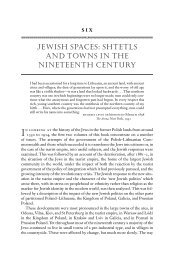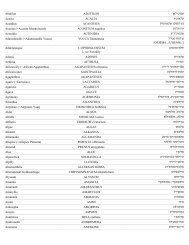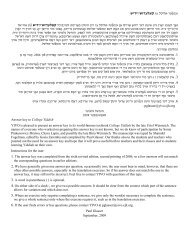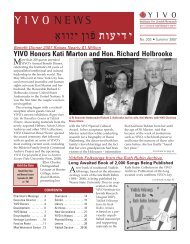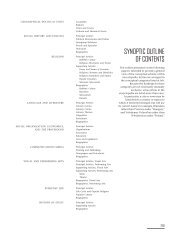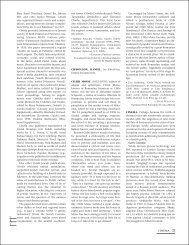t any plant names in Yiddish - YIVO Institute for Jewish Research
t any plant names in Yiddish - YIVO Institute for Jewish Research
t any plant names in Yiddish - YIVO Institute for Jewish Research
Create successful ePaper yourself
Turn your PDF publications into a flip-book with our unique Google optimized e-Paper software.
XXXVIII<br />
˘È„”È Ôȇ ËÏÚÂÂ≠ÔÒ˜ÈÂÂÚ‚ È„ Ÿ ¯ÚËÎÚ˘ È΄¯Ó<br />
[current] <strong>for</strong> the same <strong>plant</strong>, the reader is not referred from one Lat<strong>in</strong> name<br />
to the other – only the one found <strong>in</strong> Standardized Plant Names is listed.<br />
But <strong>in</strong> the case of <strong>plant</strong>s that are <strong>in</strong>digenous to the Land of Israel, we do<br />
refer the reader from one Lat<strong>in</strong> name to the other, s<strong>in</strong>ce the PNY user <strong>in</strong> Israel<br />
is more likely to use Magdir than Standardized Plant Names as his<br />
standard reference, and there is sometimes a contradiction between the<br />
Lat<strong>in</strong> <strong>names</strong> found <strong>in</strong> those two sources. Where there were discrepancies<br />
regard<strong>in</strong>g the official <strong>plant</strong> name to which none of the above-mentioned<br />
sources was able to lend its authority, PNY left these <strong>in</strong>consistencies as<br />
they were: it was not the goal of this book to play a hand at standardiz<strong>in</strong>g<br />
<strong>in</strong>ternational botanical term<strong>in</strong>ology! As such, the <strong>plant</strong> <strong>names</strong> Betula dahurica,<br />
Lillium dauricum, and Larix davurica, <strong>for</strong> example, are all listed <strong>in</strong> the<br />
Tril<strong>in</strong>gual Taxonomical Dictionary, <strong>for</strong> that is the way we found them <strong>in</strong> the<br />
Birobidzhan (USSR) sources we consulted, although the second element<br />
<strong>in</strong> these three terms is derived from the name of one s<strong>in</strong>gle river. In the<br />
<strong>Yiddish</strong>, though, we did lend a normative hand – dau'rer was selected as<br />
the term over the variants dahurer and davurer, found <strong>in</strong> the relevant <strong>Yiddish</strong><br />
literature.<br />
The <strong>Yiddish</strong> terms which appear <strong>in</strong> the Tril<strong>in</strong>gual Taxonomical Dictionary<br />
were standardized by the compiler <strong>in</strong> accordance with the follow<strong>in</strong>g<br />
pr<strong>in</strong>ciples:<br />
1. the uniqueness or differentness pr<strong>in</strong>ciple: when two or more synonyms<br />
or variants of a <strong>plant</strong> name exist, the one recommended as<br />
the standard was the more uniquely <strong>Yiddish</strong> one, the one that<br />
arose with<strong>in</strong> the realm of the <strong>Yiddish</strong> language proper.<br />
2. "the majority rules" – the synonym or variant with the largest geographic<br />
distribution or the greatest currency <strong>in</strong> the written language<br />
was selected.<br />
3. balance of spoken vs. written language: the approach that a written<br />
<strong>for</strong>m is preferable to a spoken <strong>for</strong>m was rejected. The attempt was<br />
<strong>for</strong> both to be well represented; it is naturally our desire/goal that<br />
the standardized nomenclature have roots <strong>in</strong> the spoken language.<br />
4. the shorter the word the better, unless the shorter word contradicts<br />
the above pr<strong>in</strong>ciples.<br />
5. an older liv<strong>in</strong>g/current <strong>for</strong>m is preferable to a newer liv<strong>in</strong>g/current<br />
<strong>for</strong>m, but a newer current <strong>for</strong>m is preferable to an archaism.<br />
6. semantic transparency is advisable, whenever feasible..<br />
The <strong>names</strong> of those species which beg<strong>in</strong> with stam, geveyntlekh,<br />
gortn-, esevdik, medits<strong>in</strong>ish, refue(dik) (i.e., the Lat<strong>in</strong> sativa, the English<br />
garden, etc) drop this first element <strong>in</strong> conversational speech. The spoken<br />
language is generally more economical (yet at the same time less precise)<br />
than scientifically accurate technical literature.<br />
If an <strong>in</strong>ternational term is not listed <strong>in</strong> the tril<strong>in</strong>gual dictionary, it is to<br />
be understood that a correspond<strong>in</strong>g <strong>Yiddish</strong> term does not yet exist and



